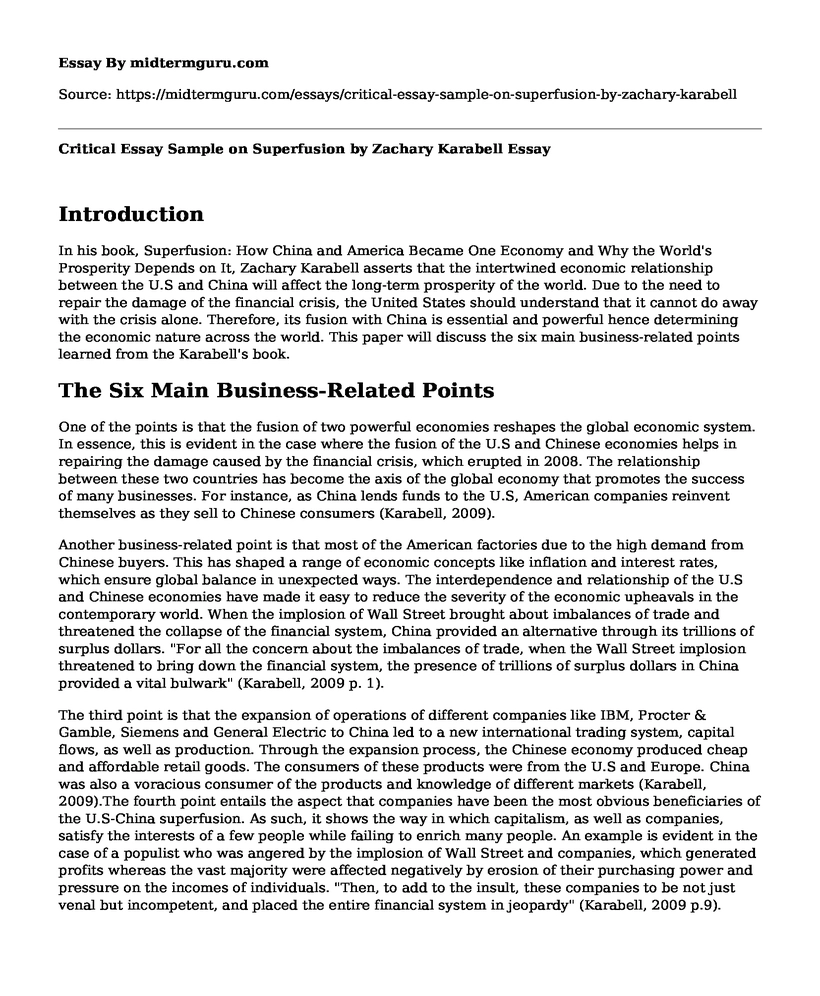Introduction
In his book, Superfusion: How China and America Became One Economy and Why the World's Prosperity Depends on It, Zachary Karabell asserts that the intertwined economic relationship between the U.S and China will affect the long-term prosperity of the world. Due to the need to repair the damage of the financial crisis, the United States should understand that it cannot do away with the crisis alone. Therefore, its fusion with China is essential and powerful hence determining the economic nature across the world. This paper will discuss the six main business-related points learned from the Karabell's book.
The Six Main Business-Related Points
One of the points is that the fusion of two powerful economies reshapes the global economic system. In essence, this is evident in the case where the fusion of the U.S and Chinese economies helps in repairing the damage caused by the financial crisis, which erupted in 2008. The relationship between these two countries has become the axis of the global economy that promotes the success of many businesses. For instance, as China lends funds to the U.S, American companies reinvent themselves as they sell to Chinese consumers (Karabell, 2009).
Another business-related point is that most of the American factories due to the high demand from Chinese buyers. This has shaped a range of economic concepts like inflation and interest rates, which ensure global balance in unexpected ways. The interdependence and relationship of the U.S and Chinese economies have made it easy to reduce the severity of the economic upheavals in the contemporary world. When the implosion of Wall Street brought about imbalances of trade and threatened the collapse of the financial system, China provided an alternative through its trillions of surplus dollars. "For all the concern about the imbalances of trade, when the Wall Street implosion threatened to bring down the financial system, the presence of trillions of surplus dollars in China provided a vital bulwark" (Karabell, 2009 p. 1).
The third point is that the expansion of operations of different companies like IBM, Procter & Gamble, Siemens and General Electric to China led to a new international trading system, capital flows, as well as production. Through the expansion process, the Chinese economy produced cheap and affordable retail goods. The consumers of these products were from the U.S and Europe. China was also a voracious consumer of the products and knowledge of different markets (Karabell, 2009).The fourth point entails the aspect that companies have been the most obvious beneficiaries of the U.S-China superfusion. As such, it shows the way in which capitalism, as well as companies, satisfy the interests of a few people while failing to enrich many people. An example is evident in the case of a populist who was angered by the implosion of Wall Street and companies, which generated profits whereas the vast majority were affected negatively by erosion of their purchasing power and pressure on the incomes of individuals. "Then, to add to the insult, these companies to be not just venal but incompetent, and placed the entire financial system in jeopardy" (Karabell, 2009 p.9).
The fifth business-related point is that China is what it is in the contemporary world due to the hybrid economy brought about by China-U.S relations. In essence, the Chinese continued to buy bonds from the United States, as well as to lend money to America (Karabell, 2009). Even though people may have a desire for autonomy, it seems to be at odds with mutual dependence reality. The sixth point to consider is the growth of the gross national product of China and America during the 1990s. "For the next eight years, the gross national product grew above trend, averaging between three percent and four percent every year until 2000" (Karabell, 2009 p. 38). The GNP grew above trend and came with low inflation rates and low levels of unemployment. It also led to a significant increase in efficiency and a decrease in oil prices. The interest rates declined substantially. Since the job market seemed strong, the number of people employed in different job sectors increased. However, the housing market in the U.S declined, and all states were affected including the resilient New York City. Conversely, the U.S, China and other countries of the world were troubled by what occurred in Russia in the 1990s and the evolution of economic reforms in the Soviet Union. "They had observed with dismay and alarm the Soviet collapse" (Karabell, 2009 p. 35).
Conclusion
The relationship between the U.S and China economies is symbiotic since it provides stability to the two societies. Through this, the American companies are seen to operate in China as Americans also purchase Chinese goods. Concisely, China is capable of acquiring adequate money and funds to lend the U.S and some to spend. In the modern world, the manner in which the relationship between these two countries is managed would help determine whether the world depicts increased prosperity or conflict between the losers and winners, haves and have-nots.
References
Karabell, Z. (2009). Superfusion: how China and America became one economy and why the world's prosperity depends on it. NY: Simon and Schuster.
Cite this page
Critical Essay Sample on Superfusion by Zachary Karabell. (2022, Oct 13). Retrieved from https://midtermguru.com/essays/critical-essay-sample-on-superfusion-by-zachary-karabell
If you are the original author of this essay and no longer wish to have it published on the midtermguru.com website, please click below to request its removal:
- Essay on the Beekeepers Apprentice by Laurie L King
- Robert Frosts Poems Analysis Example
- Essay on the Feminist Approach in the Yellow Wallpaper by Charlotte Perkins Gilman
- Literature Analysis of Beowulf - Paper Example
- Quotes From the Time Machine by H. G. Wells Analysis - Literature Paper Example
- Theme of Self-Expression in Gilman's "The Yellow Wallpaper" and Kennedy's "In a Prominent Bar in Secaucus"
- Essay Sample on Dante and Eliot Literature







